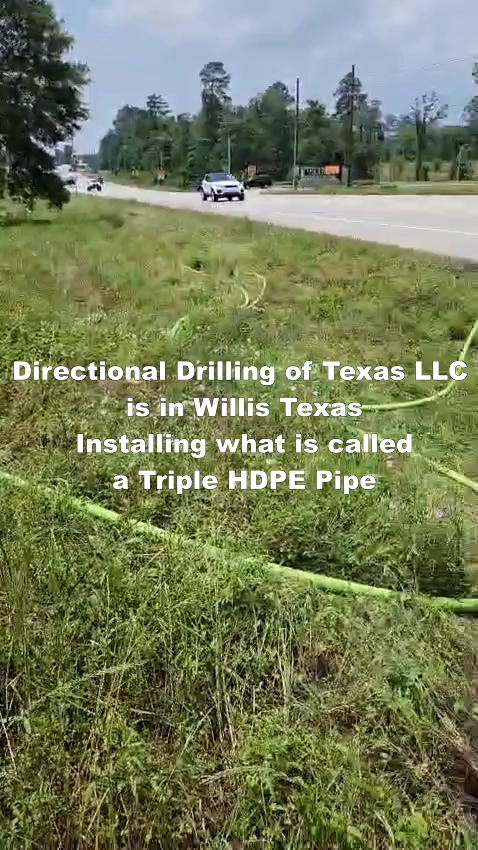For this job, we were required to drill and install more than just one underground conduit through a bore hole. We are working in Willis, a city in Montgomery County, Texas.
You can follow the process by viewing this video, so you can see exactly how it is done. We have also been able to show some of the features of the drill we use and the way it couples and uncouples the individual drill pipes and stores them in the rack.
As we have mentioned before, in today’s fast-paced, connected world, the demand for high-speed fiber optic networks is higher than ever. Installing these networks efficiently, while minimizing disruption to streets, landscaping, and existing infrastructure, is crucial. One of the most effective ways to accomplish this is through directional boring, also known as Horizontal Directional Drilling (HDD).
Here’s how Directional Drilling of Texas uses a directional drill rig to create an underground route and install conduits for fiber optic cables:
Step 1: Planning and Path Design
Before any drilling begins, careful planning is essential, including calling 811 to apprise them of locations where we will be drilling. During the 48-hour waiting period for the utilities in the area to mark their lines, our technicians conduct a site survey. Once the 48 hours have elapsed, the best underground path that avoids existing utilities, buildings, and natural obstacles is decided. Using this information, we develop a precise drill path and identify entry and exit points.
Step 2: Setting Up the Drill Rig
A directional drill rig is positioned at the location. The setup includes the drill rig itself, a drilling fluid (either water or mud) system, and tracking equipment. The drill operator and locator work together to ensure the drill head follows the planned path with pinpoint accuracy.
Step 3: Drilling the Pilot Hole
The process begins with drilling a small-diameter “pilot hole” along the predetermined underground route. The drill bit is guided horizontally beneath the surface using real-time steering systems such as a walk-over tracker, called a locator. Steering adjustments are made on the fly to navigate around any underground obstacles.
Drilling fluid, either water or a bentonite slurry, is pumped through the drill pipe to help cool the locator beacon, remove cuttings, and stabilize the borehole. The choice of water or slurry will depend on whether the ground is sandy, normal soil, or rock.
Step 4: Enlarging the Borehole
Once the pilot hole reaches the exit point, the next step is to enlarge it to the proper size needed to accommodate the conduit or, in this case, conduits. A back-hole reamer (also known as a hole opener) is attached to the drill pipe and pulled back through the pilot hole. In this particular case, as we needed to expand the bored hole from 4 to 6 inches, a chain was attached to the drill pipe and withdrawn through the original bore hole. As this chain rotated, it cut a larger path, and drilling fluid continued to flush out debris.
Step 5: Pulling the Conduit
With the borehole properly sized, the conduits, high-density polyethylene (HDPE) pipes, were attached to the drill bit using a swivel and Chinese fingers. As the drill rig pulls the drill pipes back toward the driller, it simultaneously pulls the 3 conduits through the newly created underground path.
This pulling process must be carefully managed to prevent damage to the conduit and ensure a smooth, continuous installation.
Step 6: Installing the Fiber Optic Cable
On this job, we were not asked to install the fiber optic cables, however, we can provide this service. When you install both the conduit, the fiber optic cable, and the boxes, this is called composite work. In this job, we installed a type of box called a Handhole, which you can learn more about in this article. Once the conduit is securely in place and the Handholes are installed, these act as protective sleeves through which fiber optic cables can be pulled or blown using specialized equipment. This two-stage approach ensures that the fiber optic cables are protected from soil pressure, moisture, and other underground hazards.
Why Choose Directional Drilling of Texas LLC (DDoT)?
Directional drilling, through DDoT, offers several key advantages for fiber optic cable installation:
- Minimal Surface Disruption: No need for open trenching across roads, driveways, or landscapes.
- Faster Installation: Reduced surface restoration work means projects are completed more quickly.
- Greater Flexibility: Easily navigates under obstacles like rivers, sidewalks, or existing utilities.
- Environmental Protection: Limits surface damage in sensitive or urban environments.
By combining careful planning, precision drilling, and efficient conduit installation, Directional Drilling of Texas LLC has joined the gold standard methods for expanding today’s fiber optic infrastructure.

